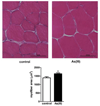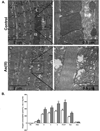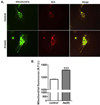Arsenic induces sustained impairment of skeletal muscle and muscle progenitor cell ultrastructure and bioenergetics
- PMID: 24960579
- PMCID: PMC4159748
- DOI: 10.1016/j.freeradbiomed.2014.06.012
Arsenic induces sustained impairment of skeletal muscle and muscle progenitor cell ultrastructure and bioenergetics
Abstract
Over 4 million individuals in the United States, and over 140 million individuals worldwide, are exposed daily to arsenic-contaminated drinking water. Human exposures can range from below the current limit of 10 μg/L to over 1mg/L, with 100 μg/L promoting disease in a large portion of those exposed. Although increased attention has recently been paid to myopathy following arsenic exposure, the pathogenic mechanisms underlying clinical symptoms remain poorly understood. This study tested the hypothesis that arsenic induces lasting muscle mitochondrial dysfunction and impairs metabolism. Compared to nonexposed controls, mice exposed to drinking water containing 100 μg/L arsenite for 5 weeks demonstrated impaired muscle function, mitochondrial myopathy, and altered oxygen consumption that were concomitant with increased mitochondrial fusion gene transcription. There were no differences in the levels of inorganic arsenic or its monomethyl and dimethyl metabolites between controls and exposed muscles, confirming that arsenic does not accumulate in muscle. Nevertheless, muscle progenitor cells isolated from exposed mice recapitulated the aberrant myofiber phenotype and were more resistant to oxidative stress, generated more reactive oxygen species, and displayed autophagic mitochondrial morphology, compared to cells isolated from nonexposed mice. These pathological changes from a possible maladaptive oxidative stress response provide insight into declines in muscle functioning caused by exposure to this common environmental contaminant.
Keywords: Free radicals; Metabolism; Mitochondria; Resistance to stress.
Copyright © 2014 Elsevier Inc. All rights reserved.
Figures






Similar articles
-
Arsenic Promotes NF-Κb-Mediated Fibroblast Dysfunction and Matrix Remodeling to Impair Muscle Stem Cell Function.Stem Cells. 2016 Mar;34(3):732-42. doi: 10.1002/stem.2232. Epub 2016 Jan 8. Stem Cells. 2016. PMID: 26537186 Free PMC article.
-
The effect of arsenic on mitochondrial fatty acid metabolism via inhibition of carnitine palmitoyltransferase 1B and choline kinase beta in C2C12 cells.PLoS One. 2025 May 29;20(5):e0320557. doi: 10.1371/journal.pone.0320557. eCollection 2025. PLoS One. 2025. PMID: 40440347 Free PMC article.
-
Alcohol induces mitochondrial fragmentation and stress responses to maintain normal muscle function in Caenorhabditis elegans.FASEB J. 2020 Jun;34(6):8204-8216. doi: 10.1096/fj.201903166R. Epub 2020 Apr 15. FASEB J. 2020. PMID: 32294300 Free PMC article.
-
The myopathy of peripheral arterial occlusive disease: part 1. Functional and histomorphological changes and evidence for mitochondrial dysfunction.Vasc Endovascular Surg. 2007 Dec-2008 Jan;41(6):481-9. doi: 10.1177/1538574407311106. Vasc Endovascular Surg. 2007. PMID: 18166628 Review.
-
Biomarkers of oxidative stress and damage in human populations exposed to arsenic.Mutat Res. 2009 Mar 31;674(1-2):85-92. doi: 10.1016/j.mrgentox.2008.09.020. Epub 2008 Oct 15. Mutat Res. 2009. PMID: 18984063 Review.
Cited by
-
Arsenic Directs Stem Cell Fate by Imparting Notch Signaling Into the Extracellular Matrix Niche.Toxicol Sci. 2020 Oct 1;177(2):494-505. doi: 10.1093/toxsci/kfaa106. Toxicol Sci. 2020. PMID: 32647881 Free PMC article.
-
A Cell-Based Approach to Study the Associations Between Mitochondrial Health, Early Life Exposures, and Consequent Health Outcomes.Front Public Health. 2019 Mar 13;7:36. doi: 10.3389/fpubh.2019.00036. eCollection 2019. Front Public Health. 2019. PMID: 30918888 Free PMC article. No abstract available.
-
Embryonic-only arsenic exposure in killifish (Fundulus heteroclitus) reduces growth and alters muscle IGF levels one year later.Aquat Toxicol. 2017 May;186:1-10. doi: 10.1016/j.aquatox.2017.02.020. Epub 2017 Feb 20. Aquat Toxicol. 2017. PMID: 28237603 Free PMC article.
-
Health Effects Associated With Pre- and Perinatal Exposure to Arsenic.Front Genet. 2021 Sep 29;12:664717. doi: 10.3389/fgene.2021.664717. eCollection 2021. Front Genet. 2021. PMID: 34659330 Free PMC article. Review.
-
Non-monotonic dose-response effects of arsenic on glucose metabolism.Toxicol Appl Pharmacol. 2019 Aug 15;377:114605. doi: 10.1016/j.taap.2019.114605. Epub 2019 Jun 3. Toxicol Appl Pharmacol. 2019. PMID: 31170414 Free PMC article.
References
-
- Mukherjee SC, Rahman MM, Chowdhury UK, Sengupta MK, Lodh D, Chanda CR, Saha KC, Chakraborti D. Neuropathy in arsenic toxicity from groundwater arsenic contamination in West Bengal, India. J Environ Sci Health A Tox Hazard Subst Environ Eng. 2003;38:165–183. - PubMed
-
- Guha Mazumder DN. Chronic arsenic toxicity: clinical features, epidemiology, and treatment: experience in West Bengal. J.Environ.Sci Health Part A Tox.Hazard.Subst.Environ.Eng. 2003;38:141–163. - PubMed
-
- Doherty TJ. Invited review: Aging and sarcopenia. J Appl Physiol. 2003;95:1717–1727. - PubMed
Publication types
MeSH terms
Substances
Grants and funding
LinkOut - more resources
Full Text Sources
Other Literature Sources
Medical

